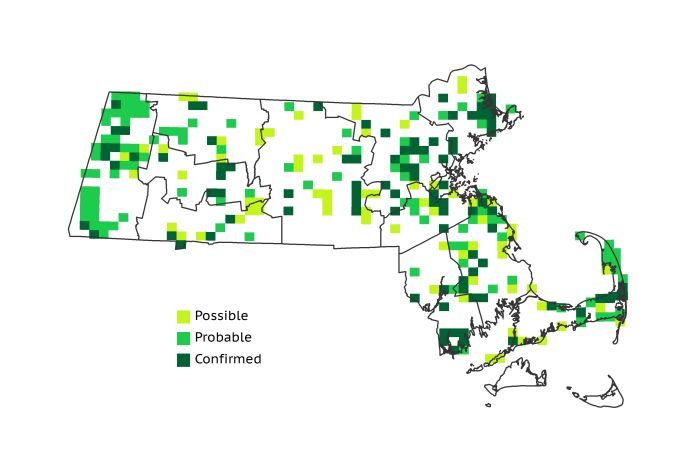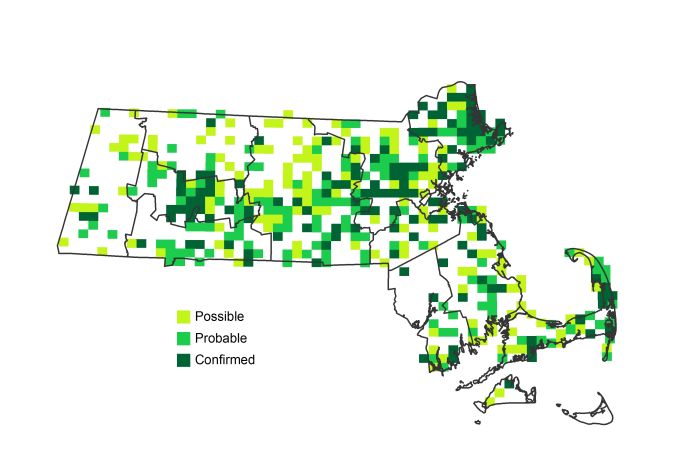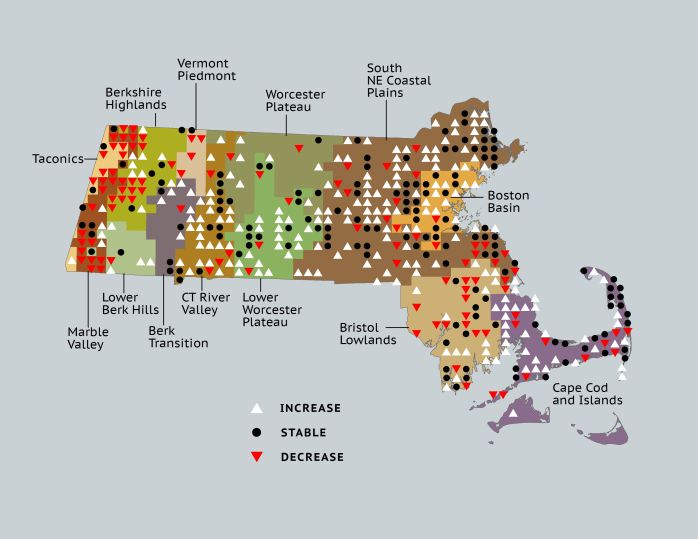Find a Bird
Great Horned Owl
Bubo virginianus

Fairly widespread and likely increasing

“My ample opportunities of fully observing these interesting birds in captivity as well as in a state of freedom, and indeed all that I have seen of them – their magnificent bearing; their objection to carrion, and strictly carnivorous tastes – would make me rank these winged tigers among the most pronounced and savage of the birds of prey.” – Ernest Seton, 1890, in Arthur Cleveland Bent’s Life Histories of North American Birds
Great Horned Owls are year-round residents in North America from the Arctic tree line to Mexico and nearly everywhere in between. They are in many ways the nocturnal counterparts of the Red-tailed Hawk, taking the night shift in hunting for small mammals and birds. Great Horned Owls are well-equipped predators in the woods of Massachusetts, inhabiting forests of every type and occasionally preying on fare as formidable as skunks and raccoons. Also content to live alongside humanity and eat the squirrels and rats that humanity attracts, Great Horned Owls seem to be doing well for themselves.
Historic Status
Great Horned Owls have long been a part of the Massachusetts landscape. Known colloquially as Cat Owls or Hoot Owls, they were familiar to early farmers as disruptors of otherwise harmonious hen yards. Through the years Massachusetts ornithologists have described them as “spirited and destructive” (Minot 1835) and “morose, savage and saturnine” (Forbush 1927), all reflective of the species’ predacious lifestyle. In an attempt to classify the species’ abundance, observers Reginald Heber Howe and Glover Morrill Allen called them, confusingly, “not uncommon” in 1900 (Howe & Allen 1901). Their nocturnal habits in the age before electricity helped them maintain an air of mystery that has not been totally dispelled even today.
Atlas 1 Distribution
Despite the chronic under-reporting of owls, Great Horned Owls were found all across the Commonwealth in Atlas 1. The Marble Valleys had a particular preponderance of reports, with breeding activity noted in two-thirds of all blocks. There was also an aggregation of owls in the western Berkshire Highlands, though the species was more sparsely distributed moving eastward into the Connecticut River Valley. Many bird species were seemingly under-reported in the Worcester Plateau during Atlas 1, including nocturnal species like owls, a phenomenon that likely accounts for the surprisingly few records from the central area of the state. Great Horned Owls were quite widespread and coexisted well with humanity in the Coastal Plains and Boston Basin. They also had a presence in the Lowlands and the Cape and Islands ecoregions, though they were absent from Nantucket and Martha’s Vineyard.
Atlas 2 Distribution and Change
It’s good to sit atop one’s food chain. The Great Horned Owl, the most populous and widespread owl species in the United States, claimed even more Massachusetts real estate between Atlas 1 and Atlas 2, considerably widening its footprint. This growth, however, came with a reshuffling in distribution. The species turned its back on the Berkshires and increased instead in the Connecticut River Valley, on the Worcester Plateau, on the Coastal Plains, and on Cape Cod. The Great Horned Owl finally reached Martha’s Vineyard in Atlas 2, although Nantucket was still devoid of breeding Great Horned Owls at the close of Atlas 2.
Atlas 1 Map

Atlas 2 Map

Atlas Change Map

Ecoregion Data
Atlas 1 | Atlas 2 | Change | ||||||
Ecoregion | # Blocks | % Blocks | % of Range | # Blocks | % Blocks | % of Range | Change in # Blocks | Change in % Blocks |
Taconic Mountains | 9 | 56.3 | 3.4 | 3 | 12.0 | 0.7 | -5 | -33.3 |
Marble Valleys/Housatonic Valley | 26 | 66.7 | 9.9 | 10 | 25.6 | 2.3 | -16 | -41.0 |
Berkshire Highlands | 18 | 32.7 | 6.8 | 13 | 23.6 | 3.0 | -5 | -9.4 |
Lower Berkshire Hills | 3 | 10.7 | 1.1 | 7 | 22.6 | 1.6 | 4 | 14.8 |
Vermont Piedmont | 6 | 35.3 | 2.3 | 3 | 17.6 | 0.7 | -4 | -33.3 |
Berkshire Transition | 5 | 13.2 | 1.9 | 13 | 32.5 | 3.0 | 7 | 22.6 |
Connecticut River Valley | 14 | 25.0 | 5.3 | 37 | 56.9 | 8.5 | 17 | 35.4 |
Worcester Plateau | 7 | 9.0 | 2.7 | 29 | 33.0 | 6.7 | 9 | 18.8 |
Lower Worcester Plateau | 17 | 23.0 | 6.5 | 44 | 55.0 | 10.1 | 15 | 27.8 |
S. New England Coastal Plains and Hills | 78 | 28.9 | 29.7 | 157 | 55.5 | 36.1 | 52 | 23.0 |
Boston Basin | 16 | 28.6 | 6.1 | 27 | 48.2 | 6.2 | 11 | 20.0 |
Bristol and Narragansett Lowlands | 30 | 28.3 | 11.4 | 32 | 28.1 | 7.4 | 1 | 1.0 |
Cape Cod and Islands | 34 | 25.0 | 12.9 | 60 | 41.7 | 13.8 | 21 | 17.5 |
Statewide Total | 263 | 27.1 | 100.0 | 435 | 41.9 | 100.0 | 107 | 12.9 |
Notes
Great Horned Owl shows a significant decreasing Breeding Bird Survey (BBS) trend in the Eastern US region.



